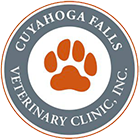A while back, in our blog post titled Fleas, Works, Ticks and other Parasites, we talked about the more common parasites that can affect our pet friends. At the end of the post we stressed the importance of monthly heartworm preventive in keeping our pets protected and limiting human exposure. Monthly heartworm preventive is good public health.
Right now we’re going to get a little bit more technical. Why? Because at the Cuyahoga Falls Veterinary Clinic, we want to have informed, educated owners.
When it comes to the anti-parasitic treatments that we give to our cats and dogs, the words on the labels mean very specific things. As an example, take a look at the Sentinel label.
Each word of the “label claim” has been carefully chosen and is designed to communicate very specific criteria… for those who understand the language. Now you have the opportunity to learn the language!
The three most commonly used terms in veterinary parasitology are Treatment, Control and Prevention.
**Treatment** refers to the ability of a given drug to remove ~90% or greater of the parasites listed in the label claim when administered at the therapeutic dosage.
**Control** means that the given drug is not capable of removing 90% of the parasite burden listed in the label claim when given as a single dose; however, regular use of the compound will greatly reduce the number of parasites and bring the infection under control over time, such as the monthly heartworm programs that “prevent” heartworm and “control” some other infections.
**Prevention** implies that regular use of the drug will prevent the establishment of the parasite infections listed on the label claim but may not have an appreciable effect on any of the established parasites.
In the case of Sentinel, the first label claim is that it “Prevents Heartworm Disease and Flea Populations in Dogs and Puppies.” Let’s break that down.
First of all, regular use of Sentinel will keep heartworms from establishing themselves in your dog. Secondly, Sentinel will keep populations of fleas from emerging. Notice that the claim is not “prevents fleas,” “treats fleas,” or “controls fleas.” Sentinel does not kill fleas, so they cannot use the previously mentioned terms. But Sentinel does prevent a female flea’s eggs from maturing, therefore they “prevent flea populations”.
Next on the label claim is “controls”
*flea populations (see above)
*adult hookworm infections
Administering Sentinel will not “cure” a dog of hookworms or fleas, but regular use of Sentinel will reduce the incidence of both of these parasites.
Finally, the label claims that Sentinel “removes and controls”
*adult roundworm infections
*adult whipworm infections
For these parasites Sentinel literally acts as a dewormer as it clears the adults that are present. Further, with regular use, it will minimize the incidence of these worms, provided the environment isn’t/wasn’t badly contaminated in the first place.
This was not meant to be a commercial for Sentinel. Pick up any antiparasitic treatment that is regulated by the FDA (ProHeart 6, Sentinel, Interceptor, Revolution, etc.) and you will see the terms that we’ve discussed above. Label claims are carefully crafted and worded to communicate very specific ideas and claims.
Lack of a Label Claim
It is important to consider that the absence of a claim may not necessarily mean that the medication is not effected for a particular parasite. Sometimes there are economic reasons why a label claim doesn’t include one parasite or another that it is, in fact, quite effective against: the studies and trials that lead to label claims are costly and there are some parasites that don’t have the public-health and/or economic importance to justify the process of achieving a label claim.
Off-Label Use
Sometimes cases arise where a pet has a parasitic disease but there is no treatment available with a label claim for the pet’s specific need. Treatments can be used for diseases or conditions that are not specifically addressed on the label claim (this is called “extralabel usage”), but in these instances, it is important that you consult with one of the doctors at the Cuyahoga Falls Veterinary Clinic and be informed of the situation and treatments limitations and risks.
Hopefully you have learned a thing or two after reading this post. If you have any questions, please bring them to our attention. Our secondary goal (having informed, educated owners) supports our primary goal: to provide kind, compassionate and comprehensive health care for your pet so that your pet may enjoy a long, happy and healthy life with you.
(Many thanks are due to the late Cliff Monahan, DVM, Ph.D., for his great work in veterinary parasitology at The Ohio State University’s College of Veterinary Medicine. Not only was he an accomplished parasitologist, but he also instilled in his students an interest in parasitology when they didn’t even know they were capable of such an interest. His teaching and his printed notes have served as the authority on veterinary parasitology for hundreds of Ohio veterinarians for many, many years.)


The Cuyahoga Falls Veterinary Clinic | Animal Wellness | Medical Services | Pet Services
[…] can be prescribed within 12 months of the patient’s most recent physical examination. (Think: Heartworm preventive, thyroid supplementation, anti-inflammatory therapy, […]
The Cuyahoga Falls Veterinary Clinic | Animal Wellness | Medical Services | Pet Services
[…] prevention is the same in both Sentinel and Trifexis: milbemycin oxime. Both Sentinel and Trifexis have similar label claims when it comes to heartworms and they have the same label claim with regard to roundworms, hookworms […]
The Cuyahoga Falls Veterinary Clinic | Animal Wellness | Medical Services | Pet Services
[…] There are differences between these are how they are given and the parasites that they prevent/control/treat. For more information on the difference between prevent and control and treat, visit our previous blog post, Parasites and Animals – Decoding the Label Claims. […]